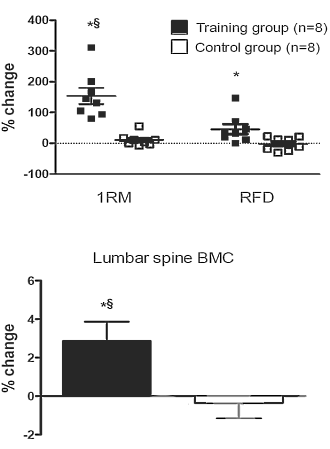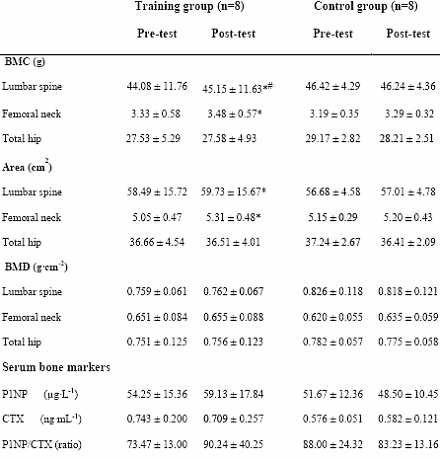Current guidelines recommend weight-bearing activities, preferably strength training for improving skeletal health in patients with osteoporosis. What type of strength training that is most beneficial for these patients is not established. Maximal strength training (MST) is known to improve one repetition maximum (1RM) and rate of force development (RFD) which are considered as important co-variables for skeletal health. Squat exercise MST might serve as an effective intervention for patients with low bone mass. We hypothesized that 12 weeks of squat exercise MST would improve 1RM and RFD in postmenopausal women with osteoporosis or osteopenia, and that these changes would coincide with improved bone mineral density (BMD) and content (BMC), and serum markers of bone metabolism. Participants were randomized to a training group (TG, n=10) or control group (CG, n=11). The TG underwent 12 weeks of supervised squat exercise MST, 3 times a week, with emphasis on rapid initiation of the concentric part of movement. The CG was encouraged to follow current exercise guidelines. Measurements included 1RM, RFD, BMD, BMC and serum bone metabolism markers; type 1 collagen amino-terminal propeptide (P1NP) and type 1 collagen C breakdown products (CTX). At post-test, eight participants remained in each group for statistical analyses. The TG improved 1RM and RFD by 154% and 52%, respectively. Lumbar spine and femoral neck BMC increased by 2.9% and 4.9%. The ratio of serum P1NP/CTX tended to increase (p=0.09), indicating stimulation of bone formation. In conclusion, squat exercise MST improves 1RM, RFD, and skeletal properties in postmenopausal women with osteopenia or osteoporosis. MST can be implemented as a simple and effective training method for patients with reduced bone mass.

